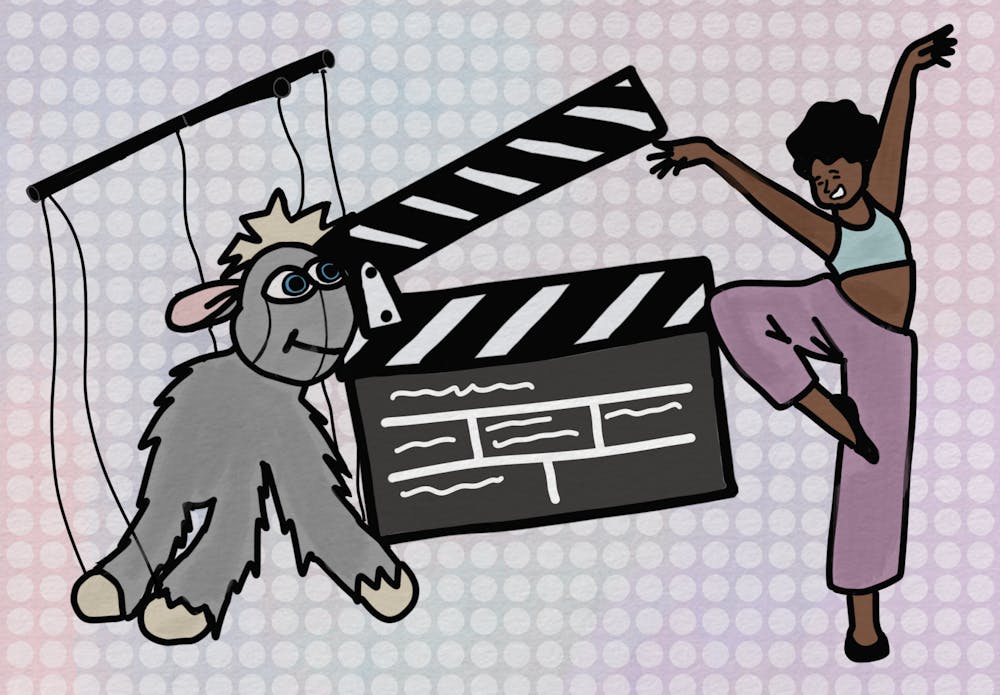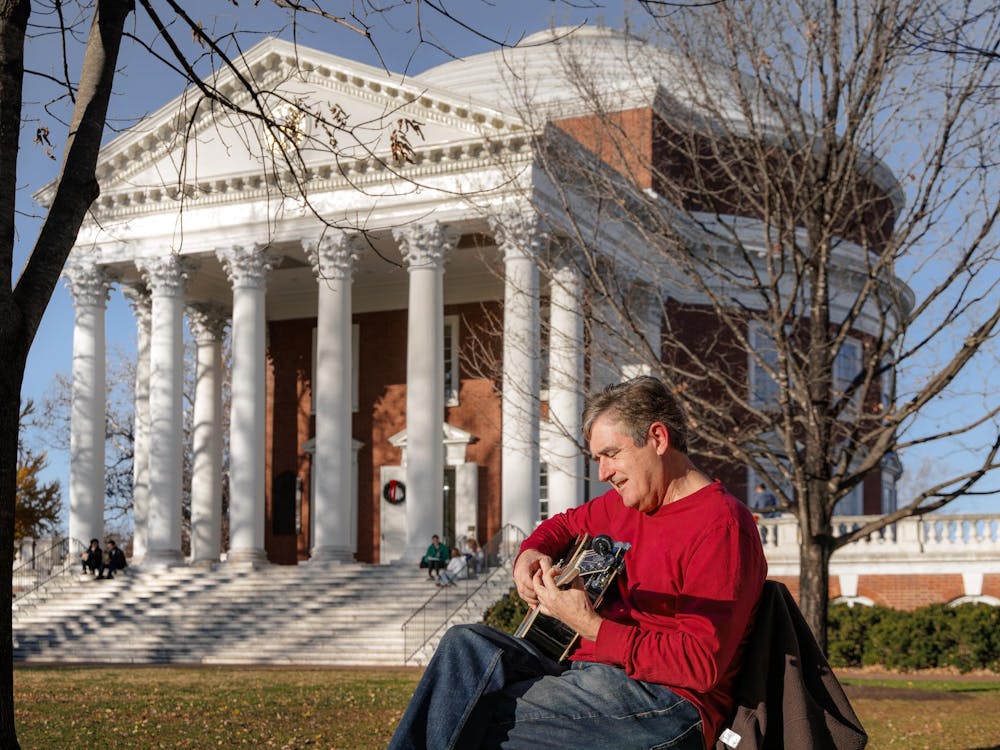Finals season saw University students across Grounds turn in essays, finish final projects or cram for exams. For many taking classes on Arts Grounds, however, their finals looked slightly different, as students showcased short films, performed dazzling dances and built larger-than-life theatrical puppets. With these creative assignments, students get the chance to dive into new disciplines, hone their crafts and demonstrate their learning in an entirely new way.
While the University’s department of drama offers many traditional classroom-based courses, several classes take students outside of the classroom setting, giving them a hands-on space to experiment with new media. One such course is the two-semester filmmaking series taught by Assoc. Prof. of Drama Doug Grissom and adjunct instructor and filmmaker Paul Wagner listed officially as DRAM 4750 and DRAM 4760, but known more commonly by its student-given nickname, Overcranked. In the course, students write several screenplays in the fall, then direct and produce one of these films in the spring.
Overcranked is a term that describes a film that appears to be in slow motion because it is shot at a higher frame rate than normal. While its name may make the class sound slow-moving, Wagner says it is anything but.
“In the fall, creatively, it's intense,” Wagner said. “And in the spring, it's intense creatively … there's a certain amount of pressure on the students — it's not an easy thing. But it's fun.”
According to Wagner, the co-instructors are not interested in producing cinematic masterpieces. Instead, the class gives students the space to craft and tell a story that is entirely their own.
“The whole focus of the class is on not becoming like a professional filmmaker — you can't really do that in one year,” Wagner said. “But what's important is that it's the vision of each student as a filmmaker. It's their idea, their script that they write and [the fact] that they personally have creative control in the writing and directing of it.”
While Grissom and Wagner provide guidance and instruction, Grissom said they avoid dictating what students can and cannot create. Instead, they try to encourage students to pursue ideas and stories that interest them most, giving student filmmakers total creative control over their projects.
“We don't cram a film down their throat, because [students] have to be enthusiastic about it,” Grissom said. “Even though we might not care for it that much as a script, it has to be something they're passionate about — they're not gonna make a better film just because we forced them to do it.”
At the end of the spring semester, students showcase their work onscreen in the Ruth Caplin Theatre at the Overcranked Student Film Festival — a culmination of all the hard work and dedication the students poured into their films.
Elsewhere in the Drama Building, students taking dance classes embody their course material physically — they complete assignments by showcasing their movement and choreography. The Dance program — a subset of the Drama Department with its own minor program — offers classes based on theory of performance, dance composition, movement practice and studio classes like ballet.
In addition to studio classes, interested students can also audition for the Spring Dance Concert, an annual recital that showcases a variety of dance styles. Once accepted, students attend rehearsals and earn class credit under DANC 2430.
Second year College student Jeremiah Clyburn is a drama and dance major who has taken several elective classes in dance. Clyburn said he appreciates the dance program because it opens up a novel way of learning in which students transform material into their own physical process.
“Once we've learned the ‘content,’ the next step of the learning process isn't just regurgitation,” Clyburn said. “It’s the creation of your own process, which, to me, teaches expansive thinking. It's allowing students to take information that they've learned and then put their own spin on it and add their own subjectivity to it, too, which to me creates knowledge.”
Clyburn also said the unique value of artistic classes lies in their ability to translate learning into a bodily experience.
“[For] a lot of artistic classes, you have the added element of being able to use this content through your body and change the way that you move through the world, or change the way that you present to the world,” Clyburn said. “To me, it's both mentally and literally physically transformative.”
Another class that facilitates physical transformation is DRAM 4597, Art of the Moving Creature. Taught by instructors Melissa Goldman and Annie Temmink, the class is cross-listed under drama and architecture departments and takes students through the process of crafting creative and visually stunning creature puppets.
The three-credit course was introduced around the same time as the first Festival of the Moving Creature, a 2013 event started by drama department technical director Steven Warner. The festival was a collaboration between several University departments and the Stan Winston School of Character Arts — an online school named after Stan Winston, Hollywood special effects artist and class of 1968 alumnus. Warner also taught the Creatures class for nine years, but after Warner’s death in 2022, Goldman said that the faculty decided to reintroduce the class in 2024 as a way of honoring him.
At the beginning of the semester, students met twice a week to brainstorm what kinds of creatures they wanted to create — not only what the characters could look like, but also what powers they would possess or the kind of personality they might have. They then spent the rest of the semester building two enormous creatures — Kiki, a curious crustacean, and Celeste, a cosmic dragon that grants wishes. Along with being imagined and built by students, members of the class also puppeteered the animals.
The students showcased their creations at the latest iteration of the Festival of the Moving Creature — a parade in which students and community members alike were invited to interact with the enormous creatures as they roamed across Grounds — April 26. Goldman said that the performance aspect was a large component of the class, as she wanted students not only to be able to conceptualize and create creatures but also to embody them as puppeteers.
“I think that [something] Annie and I really wanted students to take away is how to creatively collaborate,” Goldman said. “Because it's something that we practice when we work together, and with others, and that was really important and is, professionally, something that all of these students are going to do when they leave U.Va.”
Goldman also said the collaborative aspect of the course is crucial to its mission. According to Goldman, the entire course is based on teamwork — since they all work together on the same projects, cooperation is necessary to bring the creatures to life.
“Ideas can be so much more amazing when you bring a whole team together,” Goldman said. “I really enjoy bringing teams of people — especially coming from different disciplines — together and say, ‘Hey, you're the expert coming from here. You're the expert coming from here. How do we work together in a team and be creative?’”
Classes like Overcranked, Art of the Moving Creature and the catalog of dance classes demonstrate that learning should not be limited to a traditional classroom. Instead, new ideas flourish on the screen, on the stage and even inside a giant feathered puppet.







